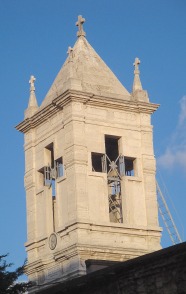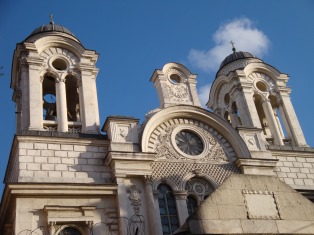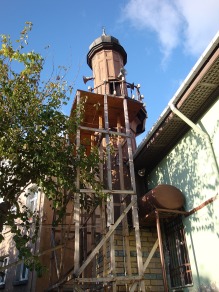“Sand Gate”
If you head west along the Sea of Marmara coast road from Kadırga the next suburb along is Kumkapı which has always been known for the many meyhanes and fish restaurants that fan out around its main square. It’s a strange sort of a place, still extremely rundown on its western side but increasingly gentrified east of the main square as tourism flows steadily down from Sultanahmet into every nearby neighbourhood. However, the return of the Kumkapı train station in 2024 may well help to pull the whole area comprehensively upmarket.
Most people come here to eat, drink and make merry, with some of the action these days spilling out through the gate in the old sea wall onto the sea side of the coast road where restaurants have now been set up right beside the fish market. But this was once an area with a large Greek and Armenian community and there are a couple of minor historical monuments to be investigated before you settle down for the evening’s entertainment.
Kumkapı orginally grew up on the site of the Byzantine Kontoskalion port that was in service right through from the fourth to the 13th centuries after which it slowly began to silt up. Since then the coast road has been built and then widened on reclaimed land, pushing the current harbour further out into the Sea of Marmara.
 Exploring Kumkapı
Exploring Kumkapı
The single most important building in Kumkapı is probably the complex attached to the Armenian Patriarchate, most obviously the huge Church of Surp Asdvadzadzin (St Mary) with the great bell-tower with crosses cut out of it. The church only dates back to 1828, previous buildings dating back to 1641 having been destroyed by fires. The complex includes the schoolhouse (1830) right next door as well as the patriarchate offices facing it across the road.
It’s here that you’ll find İstanbul’s least conspicuous museum, the Armenian Museum (appointments only – tel: 0212-517 0970, free). Basement rooms exposed by the 1999 Marmara earthquake now house some of the magnificent robes and other glittering fabrics once used in rituals in the Armenian churches around town.
Less obvious are two enormous Greek Orthodox churches. Completed in 1890 by the Greek architect Perikles Fotiades, the Neo-Byzantine Church of Hagia Kyriake (Çifte Gelinler Caddesi) is up a flight of steps behind the shops over the site of an ayazma (sacred spring) dedicated to St Basil and an earlier church probably dating back to the 16th century.
In a side street, the enormous and internally colourful Church of Panagia Elpida was completed just five years later and boasts one of the largest domes in İstanbul. It, too, stands over an ayazma, this time dedicated to St George. The wealth suggested by these three enormous churches could hardly stand in sharper contrast with the poverty of many of the battered houses in the streets around them.
 Of Kumkapı’s mosques probably the most interesting is the restored Tavaşı Süleyman Ağa Cami, its current 19th-century rendition incorporating a wooden minaret. It was originally built in the 16th century for Süleyman Ağa, the powerful Chief Black Eunuch then lording it over the Topkapı Harem.
Of Kumkapı’s mosques probably the most interesting is the restored Tavaşı Süleyman Ağa Cami, its current 19th-century rendition incorporating a wooden minaret. It was originally built in the 16th century for Süleyman Ağa, the powerful Chief Black Eunuch then lording it over the Topkapı Harem.
Eating
Time was when the Kumkapı fish restaurants had a bad reputation for skulduggery when it came to the bills. These days there rarely seem to be problems although the price of fish is not regulated so before firming up your order you should make sure you know exactly what you are asking for and in what quantities. Be careful about hanging bags on the back of seats too since there have been instances of snatching.
Kör Agop. Tel: 0212-517 2335
Yengeç Balık Restaurant (Fish Restaurant. Tel: 0212-516 3227
Sleeping
Amber Hotel. Tel: 0212-518 4801
Transport info
The suburban train line runs from Sirkeci to Kumkapı, perfect for the restaurants.
Nearby areas


